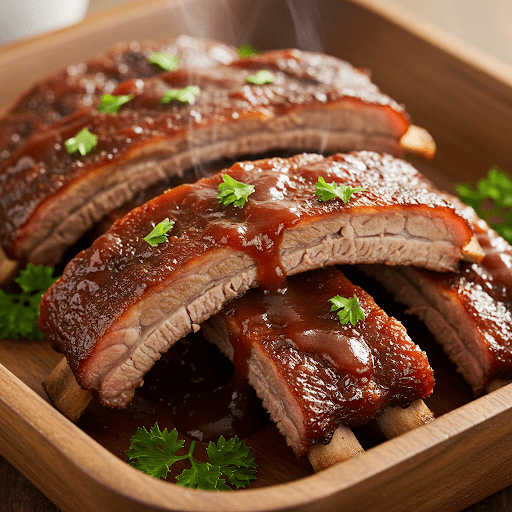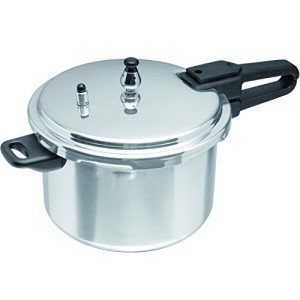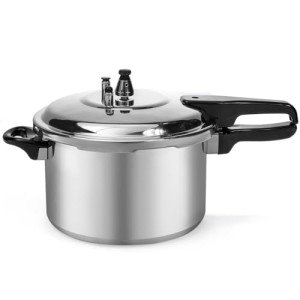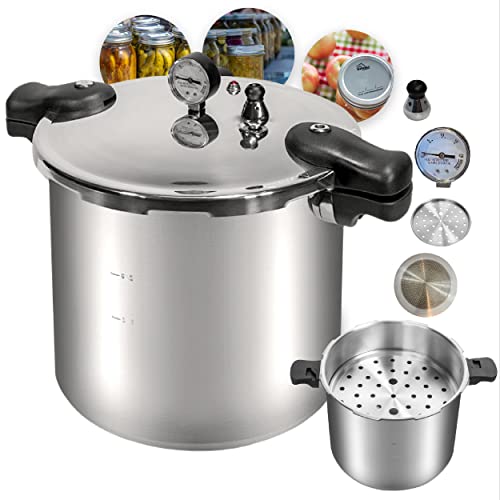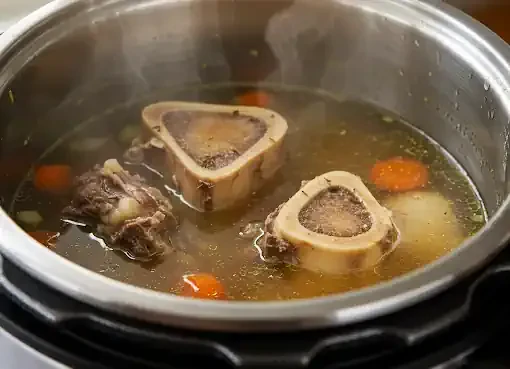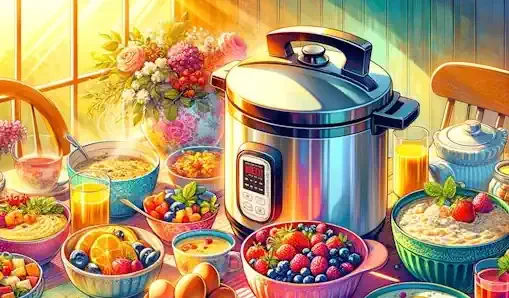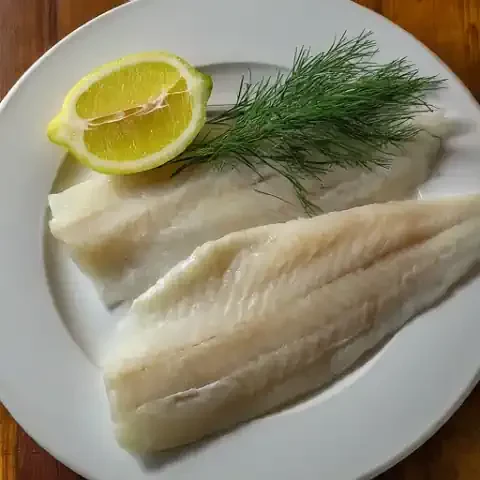The Rib Revolution
Ribs are a beloved barbecue classic, synonymous with smoky flavors, succulent meat, and finger-licking goodness. However, the traditional methods of achieving those fall-off-the-bone ribs often involve hours of slow cooking, meticulous temperature control, and a whole lot of patience. Enter the pressure cooker, a kitchen appliance that's poised to revolutionize your rib game.
The Traditional Rib Dilemma: Time vs. Flavor
For generations, barbecue enthusiasts have faced a conundrum: how to achieve that perfect balance of tenderness and flavor without sacrificing an entire day to the process. Slow cooking methods, such as smoking or braising, are renowned for their ability to break down tough connective tissues and infuse ribs with deep, smoky flavors. However, these methods require a significant time investment, often upwards of 12 hours, making them impractical for busy weeknights or spontaneous gatherings.
Enter the Pressure Cooker: A Game-Changer
The pressure cooker, with its ability to generate high heat and pressure, offers a groundbreaking solution. It dramatically reduces cooking times while still delivering incredibly tender and flavorful ribs. Imagine enjoying those same mouthwatering ribs that typically take half a day to prepare in just a fraction of the time. That's the magic of pressure cooking.
Why Pressure Cooking Is Perfect for Ribs
Pressure cooking is uniquely suited for ribs due to its ability to rapidly break down collagen, the connective tissue that makes ribs tough. The high pressure and steam create an environment that accelerates this process, resulting in ribs that are tender, juicy, and fall-off-the-bone delicious. Additionally, the pressure cooker's sealed environment locks in moisture and flavors, ensuring that your ribs are infused with the rich, smoky essence of your chosen seasonings and sauces.
A Promise of Tender, Juicy Ribs in Record Time
With a pressure cooker, you can achieve succulent, fall-off-the-bone ribs in as little as 60 minutes. This opens up a world of possibilities for weeknight dinners, impromptu gatherings, and even last-minute barbecue cravings. No longer do you need to plan your rib feast days in advance; the pressure cooker allows you to enjoy this barbecue staple whenever the mood strikes.
Dispelling Myths About Pressure Cooker Ribs
Some barbecue purists may scoff at the idea of pressure-cooked ribs, claiming that they lack the depth of flavor and smoky nuances achieved through traditional methods. However, these concerns are often based on outdated notions about pressure cookers. Modern pressure cookers are sophisticated appliances that can produce results that rival, and in some cases surpass, those of traditional cooking methods. With the right techniques and a bit of know-how, you can achieve ribs that are every bit as delicious and satisfying as those cooked low and slow.
The Science of Tender Ribs
To truly appreciate the pressure cooker's prowess with ribs, it's essential to understand the science behind tenderness. It's not just about the cooking method; it's about the intricate interplay of proteins, heat, and time.
Understanding Collagen and Connective Tissue
Ribs, particularly those from the spare rib or St. Louis cut, contain a significant amount of connective tissue, primarily collagen. Collagen is a tough protein that gives structure to muscles and bones. When raw, it's chewy and unappetizing. However, when exposed to heat and moisture, collagen undergoes a remarkable transformation.
How Heat Transforms Tough Ribs Into Tender Delights
As collagen heats up, it begins to break down and unravel, eventually converting into gelatin. Gelatin is a soft, flavorful protein that gives cooked meats their melt-in-your-mouth tenderness. This process, however, takes time. Traditional slow cooking methods rely on prolonged exposure to low heat to gradually break down collagen and transform it into gelatin.
The Pressure Cooker's Advantage: Rapid Tenderization
This is where the pressure cooker shines. The elevated pressure and temperature inside the cooker accelerate the breakdown of collagen, significantly reducing the time required to achieve tender ribs. In essence, the pressure cooker creates a fast-forward button for the tenderization process, allowing you to enjoy ribs that are fall-off-the-bone delicious in a fraction of the time it would take using traditional methods.
Why Low and Slow Isn't Always Necessary
While slow cooking methods have their merits, they are not always the most efficient or practical approach, especially for busy individuals. The pressure cooker challenges the notion that low and slow is the only way to achieve tender ribs. It demonstrates that with the right tools and techniques, you can achieve equally impressive results in a much shorter timeframe.
The Role of Moisture in Flavor and Texture
Moisture plays a crucial role in the tenderization process and the overall flavor of ribs. As the ribs cook, the moisture helps to break down the collagen and keep the meat juicy. The pressure cooker's sealed environment ensures that moisture is retained, preventing the ribs from drying out and becoming tough. This results in ribs that are not only tender but also bursting with flavor.
In the next section, we'll delve into the importance of choosing the right ribs for pressure cooking, ensuring that you start with the best possible ingredients for your culinary masterpiece.
Choosing the Right Ribs
The quest for the perfect pressure cooker ribs begins at the butcher counter. Selecting the right type of ribs and ensuring their quality are crucial steps in achieving the desired results. While all ribs share a similar structure, subtle differences in cut, size, and fat content can significantly impact the final outcome.
Baby Back Ribs vs. Spare Ribs: What's the Difference?
The two most popular types of ribs for barbecuing are baby back ribs and spare ribs. Baby back ribs are taken from the upper rib cage, closer to the backbone. They are smaller, leaner, and tend to cook faster than spare ribs. Spare ribs, on the other hand, come from the lower rib cage, near the belly of the pig. They are larger, have more fat, and require longer cooking times.
Baby back ribs: Their smaller size and faster cooking time make them a popular choice for pressure cooking. They tend to be more tender and less fatty than spare ribs, but some may find them less flavorful.
Spare ribs: While they require a bit more cooking time in the pressure cooker, spare ribs offer a richer, more robust flavor due to their higher fat content. They are also a good choice if you prefer meatier ribs.
Selecting Quality Ribs for Optimal Results
Regardless of which type you choose, selecting high-quality ribs is essential for a successful pressure cooker experience. Look for ribs that are:
Meat-to-bone ratio: Choose ribs with a good amount of meat on the bones. You don't want to be left with just bones after cooking.
Marbling: Look for ribs with a good amount of marbling (flecks of fat within the meat). This contributes to flavor and juiciness during cooking.
Freshness: Ensure the ribs are fresh and haven't been sitting in the display case for too long. They should have a vibrant color and a pleasant smell.
Identifying Freshness and Marbling
Fresh ribs should have a bright red or pink color. Avoid ribs that are brownish or have a dull appearance, as this could indicate that they are not fresh. As for marbling, look for small flecks of fat distributed throughout the meat. This fat will render during cooking, basting the meat and adding flavor.
Tips for Trimming and Preparing Ribs
Before pressure cooking, it's important to trim the ribs properly. This involves:
Removing the membrane: The membrane on the back of the ribs can be tough and chewy, so it's best to remove it. You can do this by sliding a knife under the membrane and then peeling it off.
Trimming excess fat: While some fat is desirable for flavor, you can trim away any large, thick layers of fat.
Cutting into sections: Depending on the size of your pressure cooker, you may need to cut the rack of ribs into smaller sections to fit.
St. Louis Style Ribs: A Cut Above
St. Louis style ribs are a variation of spare ribs that have been trimmed to create a more uniform rectangular shape. This makes them easier to handle and ensures more even cooking. While not strictly necessary, St. Louis style ribs can be a good option for pressure cooking if you want a consistent result.
By carefully selecting your ribs and properly preparing them, you're setting the stage for a pressure cooker masterpiece. In the next section, we'll dive into the essential tools and ingredients that will elevate your rib game to the next level.
Essential Tools and Ingredients
Equipping yourself with the right tools and ingredients is key to unlocking the full potential of pressure cooker ribs. While the pressure cooker itself is the star of the show, a few additional items and carefully selected ingredients will elevate your ribs to barbecue perfection.
The Right Pressure Cooker for the Job
Not all pressure cookers are created equal. For ribs, you'll want a pressure cooker that is large enough to accommodate a full rack of ribs or multiple smaller sections. A 6-quart or 8-quart pressure cooker is typically sufficient for most home cooks. Additionally, consider a pressure cooker with a variety of cooking functions, such as sautéing and browning, which are essential for achieving the best results.
Must-Have Accessories for Rib Success
Trivet or steamer basket: This elevates the ribs above the liquid in the pressure cooker, preventing them from sitting in the juices and ensuring even cooking.
Aluminum foil: Foil is used to create a sling for the ribs, making them easier to lower into and remove from the pressure cooker.
Meat thermometer: A reliable meat thermometer is crucial for verifying that the ribs have reached the desired internal temperature for optimal tenderness.
Building a Flavorful Rub and Sauce
The key to mouthwatering ribs lies in the layers of flavor you build. Start with a dry rub, a mixture of spices and herbs that is massaged into the meat before cooking. The dry rub creates a flavorful crust and helps to tenderize the meat. Then, during or after cooking, you can apply a wet mop or a finishing sauce to add another layer of complexity and deliciousness.
Essential Spices and Aromatics
A good dry rub for ribs typically includes a blend of the following:
Brown sugar: Adds sweetness and helps to create a caramelized crust.
Paprika: Provides a smoky flavor and vibrant color.
Chili powder: Adds a touch of heat and complexity.
Garlic powder and onion powder: Enhance the savory notes.
Salt and pepper: Seasoning essentials.
Other spices like cumin, cayenne pepper, or smoked paprika can be added to customize the flavor profile.
Liquid Smoke: Adding Authentic Barbecue Flavor
While pressure cooking doesn't replicate the smoky flavor of traditional barbecue, you can achieve a similar effect by using liquid smoke. This concentrated flavoring, derived from real wood smoke, adds a depth of smoky goodness to your ribs. Just a few drops are enough to impart a subtle smokiness without overpowering the other flavors.
By selecting the right pressure cooker, gathering essential accessories, and building a flavorful rub and sauce, you're laying the foundation for pressure cooker ribs that will rival those from your favorite barbecue joint. In the next section, we'll guide you through the step-by-step process of mastering the pressure cooker method, ensuring that your ribs emerge tender, juicy, and full of flavor.
Mastering the Pressure Cooker Method
With your ribs prepped and your ingredients assembled, it's time to unlock the pressure cooker's magic and transform those tough cuts into tender, flavorful masterpieces. This section will guide you through the step-by-step process, ensuring you achieve rib perfection in record time.
Dry Rubbing: Flavor Infusion at Its Finest
The journey to flavorful ribs begins with a generous application of dry rub. This blend of spices and herbs not only imparts a delicious savory crust but also helps to tenderize the meat. Massage the dry rub into the ribs, ensuring it reaches every nook and cranny. Allow the ribs to rest for at least 30 minutes, or even overnight, to allow the flavors to penetrate the meat.
The Importance of Browning
While the pressure cooker excels at tenderizing, it doesn't naturally create the same caramelized crust as traditional grilling or smoking. To achieve that desirable bark, browning the ribs before pressure cooking is essential. This can be done in the pressure cooker itself if it has a sauté function, or in a separate skillet. Browning the ribs creates a Maillard reaction, which enhances the flavor and adds a beautiful color to the finished product.
Layering Flavors with a Wet Mop
A wet mop is a thin sauce that is brushed onto the ribs during the pressure cooking process. It adds moisture, flavor, and complexity to the ribs. Common wet mop ingredients include apple cider vinegar, Worcestershire sauce, and spices. Some recipes call for mopping the ribs multiple times during cooking for maximum flavor infusion.
Pressure Cooking Time and Temperature
The cooking time for ribs in a pressure cooker will vary depending on the type of ribs, their thickness, and your desired level of tenderness. However, a good starting point is 30-40 minutes for baby back ribs and 40-50 minutes for spare ribs. The pressure cooker should be set to high pressure, and the temperature will typically reach around 225°F (107°C).
Natural Release vs. Quick Release
After the cooking time is complete, you have two options for releasing the pressure: natural release or quick release.
Natural Release: This method involves allowing the pressure to release naturally over time, usually 10-15 minutes. This allows the ribs to continue cooking gently in the residual heat and can result in even more tender meat.
Quick Release: This method involves manually releasing the pressure through the pressure release valve. This is faster but can cause the meat to become slightly drier.
The choice between natural and quick release depends on your preference and the specific recipe you're following. Some recipes may call for a combination of both methods for optimal results.
By mastering the pressure cooker method, you'll be able to consistently produce ribs that are tender, juicy, and bursting with flavor. In the next section, we'll explore various flavor variations and encourage you to experiment with different rubs, sauces, and ingredients to create your own signature rib recipes.
Flavor Variations and Experimentation
The beauty of pressure cooker ribs lies in their adaptability to a wide range of flavor profiles. While classic barbecue flavors are always a crowd-pleaser, don't be afraid to venture beyond the ordinary and explore the endless possibilities for customization.
Classic Barbecue Flavors: Sweet and Smoky
For those who crave the traditional taste of barbecue, a classic dry rub and sauce combination is a surefire winner. Start with a base of brown sugar, paprika, chili powder, garlic powder, onion powder, salt, and pepper. Add a few drops of liquid smoke for an extra layer of smokiness. Finish with your favorite barbecue sauce, whether it's sweet and tangy or spicy and bold.
Asian-Inspired Ribs: Umami Bomb
If you're looking for a flavor adventure, try an Asian-inspired twist on your ribs. A dry rub featuring Chinese five-spice, ginger, garlic, and soy sauce will impart a complex umami flavor. For the sauce, consider a sticky glaze made with hoisin sauce, honey, rice vinegar, and chili flakes for a sweet, savory, and slightly spicy kick.
Tangy and Spicy: Dry Rub Combinations
For those who like it hot, experiment with dry rubs that incorporate cayenne pepper, chipotle powder, or even ghost pepper powder. Combine these with other spices like cumin, coriander, and smoked paprika for a complex and fiery flavor profile. Balance the heat with a cooling element like a vinegar-based mop or a creamy slaw on the side.
Experimenting with Different Sauces
Don't limit yourself to traditional barbecue sauce. Explore a world of flavor possibilities by trying different sauces like:
Korean BBQ sauce: Sweet, savory, and slightly spicy, with a hint of garlic and ginger.
Teriyaki sauce: A classic Japanese sauce that's sweet, salty, and umami-rich.
Buffalo sauce: Tangy, spicy, and perfect for those who love a kick.
Mustard-based sauce: Popular in South Carolina, this tangy sauce is a delicious alternative to traditional tomato-based barbecue sauces.
Customizing Your Rib Experience
The beauty of pressure cooker ribs is that you can easily tailor the flavors to your personal preferences. Experiment with different combinations of dry rubs, wet mops, and sauces to create a unique taste that's all your own. Don't be afraid to get creative and try unexpected ingredients like coffee, fruit juices, or even beer in your rubs and sauces.
By embracing experimentation and stepping outside your comfort zone, you can discover a whole new world of rib flavors. In the next section, we'll offer serving suggestions and side dish ideas to complement your pressure cooker rib creations.
Serving Suggestions and Side Dishes
Your pressure cooker ribs are the star of the show, but a well-rounded meal calls for complementary side dishes that enhance the flavors and textures of the main event. Whether you're aiming for a classic barbecue feast or a lighter, more modern spread, the possibilities are endless.
Classic Pairings: Coleslaw, Mac and Cheese, Cornbread
For a traditional barbecue experience, nothing beats the classic trio of coleslaw, mac and cheese, and cornbread. The creamy, tangy coleslaw cuts through the richness of the ribs, while the cheesy mac and cheese adds a comforting element. Fluffy cornbread, with its subtle sweetness, provides a perfect counterpoint to the savory flavors of the barbecue.
Lighter Options: Grilled Vegetables, Salads
If you're looking for a lighter accompaniment to your ribs, consider grilled vegetables or a fresh salad. Grilled corn on the cob, zucchini, bell peppers, and onions offer a smoky, charred flavor that complements the ribs beautifully. A simple salad with mixed greens, cherry tomatoes, cucumbers, and a vinaigrette dressing provides a refreshing contrast to the richness of the meat.
Elevate Your Ribs with Homemade Sauces
While store-bought barbecue sauces can be convenient, nothing beats the flavor of homemade sauce. Consider whipping up a batch of your own barbecue sauce, tailored to your taste preferences. You can experiment with different ingredients like molasses, honey, mustard, vinegar, and spices to create a unique sauce that perfectly complements your ribs.
Creating a Complete Barbecue Feast
To truly impress your guests, go beyond the basics and create a complete barbecue feast. In addition to ribs and side dishes, consider adding other pressure cooker barbecue favorites like pulled pork, brisket, or chicken. Round out the meal with refreshing beverages like iced tea, lemonade, or beer. For dessert, try pressure-cooked fruit cobblers or puddings for a sweet ending to a savory meal.
Plating Tips for a Stunning Presentation
Presentation is key when it comes to serving a memorable meal. Consider the following tips for plating your pressure cooker ribs:
Stack the ribs: For a dramatic presentation, stack the ribs on top of each other on a platter.
Drizzle with sauce: Generously drizzle your homemade or favorite barbecue sauce over the ribs.
Garnish with fresh herbs: A sprinkle of fresh parsley, cilantro, or chives adds a pop of color and freshness.
Serve with accompaniments: Arrange your side dishes alongside the ribs for a visually appealing spread.
By thoughtfully selecting your side dishes and paying attention to presentation, you can elevate your pressure cooker rib dinner into a culinary masterpiece that will impress your guests and leave them wanting more.
Troubleshooting Tips and Tricks
Even with the most detailed instructions and high-quality ingredients, pressure cooking can sometimes present unexpected challenges. Don't be discouraged if your first batch of ribs isn't perfect. With a few troubleshooting tips and tricks up your sleeve, you can easily overcome common hurdles and achieve consistently delicious results.
Avoiding Common Mistakes
Overfilling the Pot: Avoid overcrowding the pressure cooker. Leave enough space for steam to circulate and ensure even cooking. If necessary, cook the ribs in batches.
Using Too Little Liquid: Always use the minimum amount of liquid specified in the recipe. This is crucial for creating steam and preventing the ribs from burning or sticking to the bottom of the pot.
Opening the Lid Too Soon: Resist the temptation to peek inside the pressure cooker while it's building or releasing pressure. This can disrupt the cooking process and affect the tenderness of the ribs.
Dealing with Tough Ribs
If your ribs are still tough after the recommended cooking time, don't panic. There are a few things you can do:
Cook Longer: Add a little more liquid and continue cooking for an additional 10-15 minutes under high pressure.
Check the Internal Temperature: Use a meat thermometer to ensure the ribs have reached an internal temperature of 195-205°F (90-96°C), which is the ideal range for fall-off-the-bone tenderness.
Shred and Sauce: If the ribs are still slightly tough, you can shred them and toss them in your favorite barbecue sauce. The sauce will help to tenderize them further and add flavor.
Preventing Burning or Sticking
To prevent the ribs from burning or sticking to the bottom of the pot:
Use a Trivet or Steamer Basket: This elevates the ribs above the liquid, preventing direct contact with the hot surface.
Deglaze the Pot: If you brown the ribs in the pressure cooker, deglaze the pot with a little liquid (water, broth, or beer) before adding the ribs back in for pressure cooking. This will help to loosen any browned bits stuck to the bottom.
Adjusting Cooking Times for Different Cuts
Remember that different cuts of ribs may require slightly different cooking times. Baby back ribs generally cook faster than spare ribs. It's always a good idea to check the ribs for tenderness before releasing the pressure. If they're not quite done, simply cook them for a few more minutes.
Making the Most of Your Leftovers
Leftover pressure cooker ribs are a gift that keeps on giving. You can shred them and use them in tacos, sandwiches, salads, or even pizza. You can also freeze them for later use. Reheat the ribs in the pressure cooker or oven until warmed through, and enjoy the flavors of your barbecue feast all over again.
By mastering these troubleshooting tips, you'll be well-equipped to handle any unexpected challenges that may arise during your pressure cooker rib adventures. With practice and a little bit of patience, you'll soon become a pressure cooker rib expert, delighting your family and friends with tender, juicy, and flavorful ribs every time.
Beyond Ribs: Other Pressure Cooker Barbecue Delights
While ribs undoubtedly steal the spotlight in the pressure cooker barbecue realm, don't let their fame overshadow the myriad of other barbecue delights that can be achieved with this versatile appliance. From succulent pulled pork to tender brisket and even vegetarian options, the pressure cooker opens up a world of possibilities for your next barbecue feast.
Pulled Pork: Shredded Perfection
Pulled pork, a staple of Southern barbecue, is renowned for its melt-in-your-mouth tenderness and smoky flavor. Traditionally, it requires hours of slow cooking to break down the tough connective tissue and render the fat. However, the pressure cooker can accomplish this feat in a fraction of the time. A pork shoulder, seasoned with a flavorful rub and cooked in a mixture of liquid smoke, vinegar, and spices, emerges from the pressure cooker ready to be shredded into succulent, flavorful strands.
Brisket: Melt-In-Your-Mouth Tenderness
Brisket, a notoriously tough cut of beef, is often considered the holy grail of barbecue. Achieving that melt-in-your-mouth tenderness typically involves hours of smoking or slow roasting. However, the pressure cooker can work its magic on brisket as well, transforming it into a tender, juicy masterpiece in a matter of hours. By braising the brisket under pressure with flavorful liquids and aromatics, you can achieve results that rival those of traditional methods.
Chicken: Juicy and Flavorful in Minutes
Chicken, a versatile protein, lends itself beautifully to pressure cooking. Whether you're craving barbecue chicken breasts, thighs, or even a whole chicken, the pressure cooker can deliver juicy, flavorful results in a fraction of the time it would take in the oven or on the grill. Season the chicken with your favorite dry rub or marinade, add a bit of liquid smoke for smoky depth, and let the pressure cooker do its thing. You'll be amazed at how quickly and easily you can create a delicious barbecue chicken feast.
Beyond Meat: Vegetarian and Vegan Options
Pressure cooking isn't just for meat lovers. It's also a fantastic tool for creating vegetarian and vegan barbecue dishes. Jackfruit, a tropical fruit with a texture that resembles shredded meat, can be transformed into a smoky, savory pulled "pork" alternative in the pressure cooker. Seitan, a wheat-based protein, can be pressure-cooked to mimic the texture and flavor of traditional barbecue meats. With a little creativity and the right seasonings, you can create plant-based barbecue dishes that are just as satisfying as their meat-based counterparts.
Exploring the World of Pressure Cooker Barbecue
Don't limit yourself to just ribs, pulled pork, and brisket. The pressure cooker can be used to create a wide variety of barbecue-inspired dishes, from smoked sausages and hot links to baked beans and collard greens. Explore different regional barbecue styles, experiment with different flavors and ingredients, and discover the endless possibilities that pressure cooking offers for your next barbecue adventure. The only limit is your imagination!
Embrace the Pressure Cooker
The pressure cooker has undeniably earned its place as a kitchen essential, transforming the way we approach barbecue and proving that delicious, fall-off-the-bone ribs don't have to be a time-consuming endeavor. By harnessing the power of pressure and steam, this versatile appliance unlocks a world of culinary possibilities, making it easier than ever to enjoy mouthwatering ribs whenever the craving strikes.
Recap of the Benefits of Pressure Cooker Ribs
Throughout this guide, we've explored the numerous advantages of pressure cooking ribs:
Unmatched Speed: Forget the 12-hour marathon. With a pressure cooker, you can achieve succulent, tender ribs in under an hour.
Flavor Infusion: The pressure cooker's unique cooking environment intensifies flavors, resulting in ribs that are bursting with savory, smoky goodness.
Nutrient Preservation: Shorter cooking times and a sealed environment help to retain essential vitamins and minerals, making pressure cooker ribs a healthy and delicious choice.
Versatility: From classic barbecue flavors to international inspirations, the pressure cooker allows you to experiment with a wide range of rubs, sauces, and ingredients to create your own signature rib recipes.
Convenience: The pressure cooker simplifies the cooking process, making it easy to enjoy ribs on busy weeknights or for impromptu gatherings.
A Faster, Easier, and Equally Delicious Way to Barbecue
The pressure cooker challenges the notion that slow cooking is the only way to achieve barbecue perfection. It demonstrates that with the right tools and techniques, you can achieve equally impressive results in a fraction of the time. Whether you're a seasoned pitmaster or a novice cook, the pressure cooker empowers you to create mouthwatering ribs that will impress your family and friends.
Encouragement to Experiment and Create
Don't be afraid to step outside your comfort zone and explore the endless possibilities that pressure cooking offers. Experiment with different cuts of ribs, try new flavor combinations, and discover your own signature recipes. The pressure cooker is a versatile tool that can inspire culinary creativity and expand your barbecue repertoire.
Sharing Your Rib Masterpieces with Friends and Family
Once you've mastered the art of pressure cooker ribs, don't keep the deliciousness to yourself. Share your culinary creations with friends and family, hosting a barbecue feast that will be the talk of the town. The joy of cooking is amplified when shared with loved ones, and pressure cooker ribs are sure to be a hit at any gathering.
Pressure Cooking: A Gateway to Culinary Confidence
The pressure cooker is more than just an appliance; it's a gateway to culinary confidence. By mastering this versatile tool, you'll gain the skills and knowledge to tackle a wide range of dishes, both simple and complex. You'll discover the joy of experimenting with flavors, textures, and ingredients, and you'll find yourself spending less time in the kitchen and more time enjoying the fruits of your labor. So embrace the pressure cooker revolution and unlock a world of culinary possibilities!
